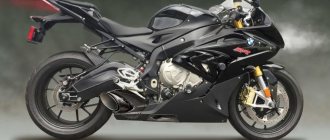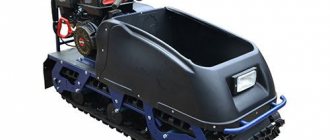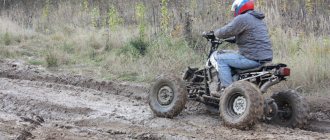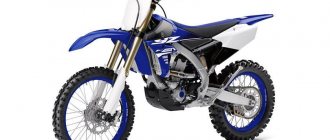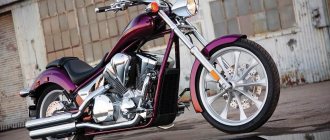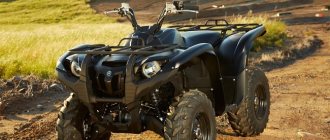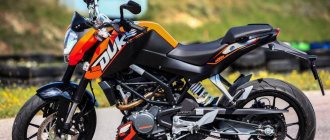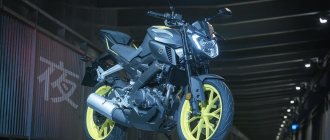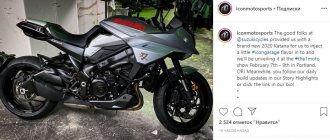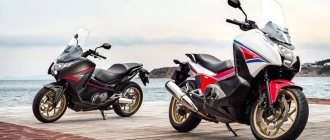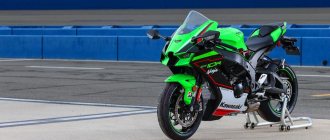It's been ten years since BMW first introduced the almighty BMW S1000RR sportbike, the bike that spearheaded the 200 hp era. In 2021 they released the third generation of the evergreen German superbike BMW s1000rr.
Racing motorcycle sportbike BMW S1000RR, BMW s1000rr, BMW s1000rr
Here are interesting facts about the BMW S1000RR:
BMW S1000RR sportsbike is one second faster
One second is just a moment in the life of mortal men, but in the world of superbike racing it represents a bright year of success on the track. One of the goals set by the BMW team for the 2021 S1000RR was that it should be one second faster on the track than its predecessor - a goal they confidently claim to have achieved.
Sports bike BMW S1000RR, BMW 1000rr
When 200 hp. not enough anymore
Ten years ago, 200 hp. or even close to 200 hp. were the preserve of motorcycle gods. Many people believed that these types of “beasts” could not be “tamed” by mere mortals, and some even called for government intervention. As is the case with progress, today 200 hp. already seem quite banal. With the Ducati Panigale V4 and Aprilia RSV4 delivering more than 210 hp, the need to breed such “horses” is urgent.
At the same time, the new BMW S1000RR motorcycle develops power up to 207 hp, which is eight units more than its predecessor. Although he is perhaps a few steps behind the Italians, we must remember that these are German claims and they tend to be somewhat modest. We're betting that when the real BMW s1000rr charms private buyers, the numbers will be very similar to the Italian ones, and perhaps even surpass them.
BMW S1000RR, BMW s1000rr motorcycle
Specifications
Full characteristics of the BMW S1000 RR superbike are given in the table:
| Characteristics and performance of the BMW S1000 RR | ||
| Parameter | Unit change | Index |
| Length | mm | 2050 |
| Sharina | mm | 826 |
| Height | mm | 1140 |
| Seat height | mm | 815 |
| Curb weight | kg | 204 |
| Engine | type | 4-cylinder, 4-stroke, in-line |
| Working volume | cube cm. | 999 |
| Power | hp | 198 |
| Transmission | type | sequential, 6-speed |
| Drive unit | type | Chain |
| Volume of the tank | l | 17,5 |
| Maximum speed | km/h | More than 200 |
| Average consumption | l | 5,9 |
First variable cam technology on a superbike
bmw s1000rr specifications –
BMW debuted ShiftCam technology on their yet-to-be-released R1250GS, and launch reports suggest it's the system of choice. In principle, it works similarly to Honda's V-Tec system, in which different cams with different profiles are engaged at certain rpms, offering a better powerband across all rpms, but if 1250 is what you're looking for, then that's a whole different story.
First, the cam shift does not occur at a predetermined rpm point, but rather the electronics work out the best point to shift the cams based on various conditions such as rpm, gear, throttle, speed and conditions. Plus, the shift is completely unnoticeable and the only response is more usable power everywhere.
BMW S1000RR, bmw s1000rr specifications
Upgrade ver. 2.0
The test drive of the BMW S1000RR'2015 took place on another Spanish track, the almost 4.5-kilometer Circuito Monteblanco, where the engineers of the Bavarian concern no longer skimped on the technical details of the new product, which has changed in almost everything. The engine was significantly modified (a new cylinder head with a different channel geometry, a new intake camshaft and lightweight intake valves), and the power system was also modernized (the channels became shorter, the air filter box was larger, and the damper drive was exclusively electronic). The motorcycle received a completely new “release”, which, due to the abandonment of the stepped design with several chambers and after “packing” all the required elements into one muffler, became 3 kg lighter.
As a result, the performance of the BMW inline-four has increased, and the engine now produces an impressive 199 hp. With. maximum power and 113 Nm of torque. That is, the new S1000RR is even more powerful than the previous flagship of the German brand’s sports bike line, the exclusive HP4!
German engineers especially noted the increase in traction in the range from 5,000 rpm and its more linear delivery, as well as the fact that maximum torque is available from approximately 9,500 to 12,000 rpm. The new S1000RR has three driving modes as standard ( Rain, Sport and Race), and after installing the optional Race Package, you have access to two additional programs - Slick and User.
Moreover, the last so-called “custom” mode allows the rider to configure numerous parameters of the motorcycle systems to suit his taste, riding style and conditions of a particular track. The Race Package also provides the S1000RR with two extremely useful systems for sport use of the motorcycle: Launch control, which helps the pilot perform racing starts without the risk of capsizing due to careless operation of the clutch and gas, as well as a Pit-lane limiter, the use of which prevents the sports bike from reach a speed above 60 km/h and, accordingly, violate the limit set in the pit lane.
The electronics have also been seriously updated, without which a modern production superbike is unthinkable. The almost standard Race ABS has received optimized settings, the sensitivity of the DTC traction control system can now be manually adjusted from -7 to +7 units, and the motorcycle's electrics have been significantly redesigned, plus the battery has become a little lighter.
As options, the new S1000RR can be equipped with an improved version of the DDC adaptive suspension (virtually the same as the HP4 model), as well as a two-way HP Gear Shift Assist Pro quickshifter. The parade of high technologies of the German industry is completed by an updated dashboard, which provides such a volume of various information that to master it it would not be superfluous to read the instruction manual, and... cruise control, which BMW engineers suddenly installed on the new 199-horsepower S1000RR!
However, in Germany with its autobahns it will not be difficult to find a use for it. The chassis of the model was not left unchanged: for example, the motorcycle frame was modified (in particular, its lower section was significantly modified) and the chassis geometry was changed (the new generation S1000RR has a different fork angle and reach, a different wheelbase). As a result, the new BMW weighs 4 kg lighter than the previous generation unit, and the curb weight of the 2015 S1000RR is 204 kg.
BMW S1000rr motorcycle is more than 11 kg lighter
Also on the list of goals was that the new BMW 1000 model should be at least ten kilograms lighter. While the latest model did receive consistent praise, its one major flaw was that it was a bit of a rush.
BMW's toned down this by tapping into the fashionable history of mass centralization, but while that philosophy has its merits, the best way to give a moto a lightweight look is to make it lightweight. The official statement says the new model is 11kg lighter than the previous one, with a curb weight of 197kg, but BMW had to work even harder.
This model adds Euro4 compliance restrictions plus the additional weight of the ShiftCam. This means that the engineers actually achieved a record of much more than just 11 kg. Much of this weight loss comes from the engine, which is now four kilograms lighter despite the ShiftCam.
They focused on taking weight off moving parts like the crank and flywheel, which means the engine should spin faster. A further 1.3kg has been trimmed from the exhaust, meaning the rest comes from the chassis, which has been reduced by packing more load-bearing capacity onto the engine.
BMW S1000RR. bmw s
Design features, advantages
The engine used on this bike is a 4-cylinder, in-line, high-revving engine. It works with a 6-speed sequential gearbox .
The drive to the wheel is carried out by a chain. The frame on the motorcycle is aluminum, lightweight. The engine of this motorcycle is an element of the power structure.
The rear wheel is suspended by an aluminum pendulum suspension with a monoshock absorber. This harness includes a wide range of settings .
At the front, an inverted telescopic fork ; it also has adjustments.
What this motorcycle has a lot of is electronic systems. The engine is powered by an electronic injection system.
There is an electronic engine control unit, which has 5 operating modes that allow you to customize engine operation under certain conditions.
Other electronic systems installed on the S1000 RR include Rase ABS, ASR and DTC. In addition, there is cruise control and such a nice little thing as heated steering wheel grips .
And the steering of the new BMW S1000rr has also become lighter
With less weight, the suspension geometry should make steering even easier. The developers' latest trick is to reduce the steering angle, make the steering quicker, and then increase the wheelbase to keep the bike stable.
The steering angle is 0.4 steeper at 66.9, and the wheel is reduced by 3.4 mm. Meanwhile, the wheelbase is nine millimeters longer. At the same time, the weight distribution on the front wheel also increased from 52.3% to 53.8%.
BMW S1000RR
The new BMW S1000rr doesn't just go around one lap in a second
BMW has taken several steps to ensure that the second lap is maintained throughout the course or race. The first step was to move the rear shock further away from the engine so it wouldn't be exposed to unnecessary heat.
There is a new clutch system which means shock load can be reduced to 117mm instead of the previous 120mm, plus a larger piston inside the shock helps reduce heat build-up.
The front forks have been reduced from 46mm to 45mm to further reduce weight. There is an option for BMW's rather clever Dynamic Damping Control which can fully engage the damping in just 10ms, meaning it will constantly re-adjust the suspension not just on every stretch of road, but on every single knob.
BMW S1000RR, BMW s1000rr motorcycle
Superbike appearance
The S1000 RR looks more than serious. The front part is almost completely covered with fairings and trims , but at the back everything is open and accessible for viewing.
We streamline the front of the bike as much as possible. They didn’t forget about the trademark of the front of the motorcycle – asymmetrical headlights located between the air intake of the upper part of the fairing.
The top ends with plastic glass , behind which the dashboard is hidden.
The front wheel is equipped with powerful brake discs. The wing sits low above the wheel and is small in size.
Behind the wheel, only a wide radiator is visible, covered on the sides by fairings.
The bottom of the engine, frame and exhaust system are covered with plastic protection.
From the side, the engine is practically invisible due to the lining; it is only slightly visible through the air intakes, stylistically designed in the form of shark gills .
But between the side overlays the diagonal stripes of the frame are clearly visible . On top there is a solid “hump” of the fuel tank, in front of which the steering wheel is located.
Behind the tank is a small triangular-shaped driver's seat . The rear wing begins from the saddle.
Since this sports motorcycle is serial and can be ridden on general purpose trails , it is a two-seater, but the passenger seat is very small and located high on the rear fender.
The end of the wing is decorated with an LED rear brake light of a very original shape . On the right is a dual exhaust pipe housed in a stylish housing.
A brief overview of the Suzuki Katana motorcycle lineup, technical characteristics of the most popular representatives of the line.
This bike is considered one of the best in its class:
Lightweight wheels keep getting better
The 17-inch alloy wheels of this new BMW s1000rr motorcycle model weigh only 1.6 kg less than the previous model. Lighter wheels improve every aspect of the motorcycle - acceleration, braking, steering, lean, stability, tire life and suspension. To add to this, the 320mm steel brake discs also weigh 0.5kg less.
BMW S1000RR, BMW s1000rr motorcycle
A little history
This supersport appeared not so long ago, in 2008, but it became the first dual-purpose production model .
Other motorcycle manufacturers began to appear such bikes later. Later, the Bavarians updated the model, but only slightly - they replaced the dashboard and slightly adjusted the appearance of the side fairings. An updated model appeared in 2012.
By this year, it could be noted that the 2012 model was somewhat outdated. The Bavarians also understood this, so in 2015 they presented a new model, the S1000 RR, quite well redesigned.
Almost everything about the new model has been revised - the power plant, the frame, the position of the fairings. Only the transmission was not affected.
All modifications have led to an increase in torque power, a reduction in the weight of the motorcycle, and improved aerodynamics. They also added auxiliary systems , which at one time were a novelty for production motorcycles.
No more unreliable “eyes”
The bad headlights are gone and the replacements look ridiculously good. BMW says modern breakthroughs in LED lighting mean they can produce decent low and high beams by using less symmetrical headlights instead of having one big one.
The two headlights are no longer inserted into the nose fairing, but are positioned underneath it in the same way as on the current Yamaha R1. The indicators are now integrated into the mirrors, making them easier to remove during track racing.
BMW S1000RR, BMW s1000rr sportbike
M versions also come to motorcycles
The BMW automotive industry is famous for its M cars or optional packages called M Parts. BMW Motorrad has always offered performance parts, but now they are officially labeled as "M Performance Parts". The list of parts is long and they are mostly carbon fiber. Unlike the automotive segment, I doubt that we will see fake M versions of the BMW s1000rr sportbike anytime soon
BMW S1000RR, BMW s1000rr sportbike
BMW s1000rr video:
Post Views: 11,430
Attraction
The transmission performance of the new S1000RR deserves special attention. Firstly, with the 2015 model, German engineers have finally made it much easier to change the gearbox algorithm from standard to inverted, which is used by most racers. And if previously, in order to “reverse” the gearbox, it was necessary to disassemble half the motorcycle, then on the new product it is enough to unscrew a couple of bolts and rearrange the linkage in two minutes!
Secondly, the BMW sportbike has an excellent slipper clutch as standard, which is efficient and durable. And thirdly, the optional two-way quickshifter turns the process of shifting gears into a computer game; to change the transmission stage you just need to press a button (in the case of the S1000R, on the gearbox foot)! The only condition is that when resetting the gear down during braking, the “gas” must be closed, and spectacular throttle changes are no longer required, since the system itself increases engine speed at the right moment. The future is already here...
In terms of handling, the new S1000RR has become almost indistinguishable from the HP4, at least when equipped with the adaptive DDC suspension. Unfortunately, the base model with a conventional fork and monoshock was not tested in Spain, and therefore I cannot judge how much the chassis of the latest generation has stepped forward (or not...) compared to the chassis of the previous S1000RR.
But it’s a fact that the DDC system, coupled with a few chassis changes, improved the motorcycle’s handling! As much as the HP4's composure and handling precision differed from the previous S1000RR, BMW's new product surpasses its predecessor. Of course, the braking system here matches everything else and reflects the very essence of the model: first-class hardware, supported by impeccable electronics. Moreover, it is not clear what ultimately prevails.
I was very impressed by the work of the anti-stoppie system in Race mode, with which hard braking “on the ears” after the long straight line of the Monteblanco Circuit, where the speedometer showed just over 280 km/h, turned into an exciting “wait for the anti-stoppie” attraction. It was clearly felt that the S1000RR covered tens of meters on the front wheel, without exceeding the critical angle of inclination included in the Race program - and therefore I was not particularly worried about my safety and the integrity of the motorcycle.
But still, he played it safe and slightly released the brake lever, which returned the rear wheel of the German sportbike to the sinful Spanish soil... that is, asphalt.
